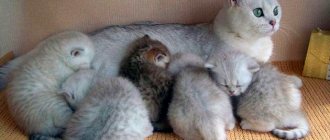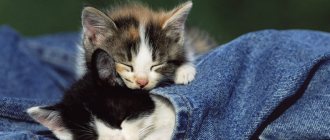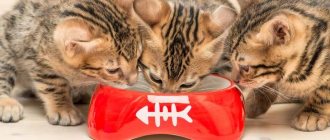When a cat has given birth, the owner should know at what age it is possible to wean and give away offspring without causing harm to the babies and mother. The future owner needs to become familiar with the characteristics of newborn kittens and know the optimal weaning time. In order for the pet to grow up healthy, the owner needs to provide care for the kitten and take care of feeding.
According to breeders, it is recommended that a purebred baby be taken away and given away at the age of 3-4 months, since by this time signs of the breed appear and the baby's hair falls out.
Features of newborn kittens
Immediately after birth, the cat releases the babies from the amniotic sac, which allows the kitten to take its first breath. The babies are wet at this time, the mother licks them and later pushes them towards the nipples. Main features of babies:
- Dream. During the first and second weeks, kittens eat and sleep most of their lives. During sleep, the baby may shudder, move his paws, and smack his lips. This indicates the active phase of sleep and is normal. For the first 2 days, cats sleep with their heads tilted towards their chest.
- Weight. Normal full-fledged babies weigh 70-130 g, gradually gaining weight.
- Vision and hearing. Kittens are born blind with closed eyes, which should open in 1-2 weeks. During this period, the cubs begin to hear.
- Touch and smell. Developed because the kitten smells milk, so it approaches the cat’s belly and grabs the nipple.
- Sucking reflex. Very developed. If a kitten is taken away early, the instinct remains for a long time, even when the baby grows into an adult cat and sucks the owner's hand.
- Defecation. The kitten does not yet know how to go to the toilet on its own, so the cat must stimulate the tummy by licking it in the genital area. At 1 month, the baby can already go to the tray on his own, which his mother teaches him to use.
- Leather and wool. Always clean and well-groomed, the skin is light pink and elastic.
- Behavior. The older the kitten gets, the more intensely it moves and shows curiosity, getting out of the box or basket. Therefore, inactive babies may be sick, and in a Scotsman or Briton this indicates osteochondrodysplasia.
Cat etiquette rules
Also, up to 3 months, the mother still teaches the kittens the rules of etiquette - using a scratching post, a tray and other points, for example, not to let out their claws during play. A person can teach this, but it’s more difficult for him to do it than for his mother. A person without experience raising cats will have a hard time. If you do not want to have problems with such basic rules of cat life, as well as with the manifestation of infantile behavior in an already adult cat (for example, sucking human clothes and hair and similar oddities), you need to adopt a kitten at an older age.
When can you separate a kitten from a cat?
Kittens can be given away no earlier than two months after birth, and the new owners need to pay maximum attention to the babies.
Scottish Folds can be adopted after their ears drop, but not earlier than 2 months. Separating a one-month-old baby from its mother is not recommended, since it is stressful for the offspring and the cat, leads to psychological illnesses and even ends in death. The optimal age for giving away kittens is from 12 weeks. Being deprived of maternal care at 7 weeks, the babies still need their mother, which means that the owners will have to pay maximum attention to the new residents. If a cat abandons the kittens, does not respond to them and does not feed them, the cubs are taken away and transferred to artificial nutrition. In this case, you can give the kitten away immediately, provided that the owner devotes himself entirely to care and feeding.
How to prepare kittens for separation from their mother
Mother's milk is important for a pet. Kittens receive nutrients and antibodies to strengthen their immunity. There is no need to prepare animals for separation. To understand how many months kittens are given away, keep in mind that at the age of 7-8 weeks they no longer need milk as the only source of nutrition.
The cat itself drives away annoying individuals from the nipples, although out of habit the pets can fall on them for up to 5-6 months. If the animal continues to lactate, it is recommended to allow the young to suck the milk once a day. The transition to adult food can be made easier by adding low-fat cottage cheese and natural sourdough yogurt to the menu. After weaning, kittens are given special canned meat, boiled chicken, and beef.
How to give away your baby correctly?
A nursing cat has a very developed instinct for preserving offspring, so tearing all the kittens away from her at once is cruel and dangerous to health. It is better if the future owner comes to the house, sometimes picks up the baby and returns it to the mother. So, she will understand that the person does not take away the cub. The kitten also needs to get used to new smells and sensations. Therefore, babies need to be selected gradually in this way:
- They give clothes or an item from the new owner so that the kitten gets used to the foreign smell.
- The future owner should visit the baby regularly so that he gets used to the smell and touch.
- You can take the cat away from its mother for 2-3 hours so that new family members can interact with the pet.
- You should not select offspring if the cat is against it, does not give up the cubs, hisses and growls. It's better to wait a little and try again in a few days.
- When a kitten is given away to a new family for good, it is advisable to take bedding from the old room so that the baby is comfortable and has the smell of his mother nearby.
- When the last kitten is given away, everything that smells of the cubs and reminds of them is gradually taken away from the cat.
What socialization skills are desirable for trouble-free adaptation to new conditions?
Physiological indicators are, of course, of great importance for independent living. In a cat family, while playing with its brothers and sisters, the kitten strengthens its muscles, learns to control its body, and acquires fighting and defense skills. Mother teaches kittens to hunt.
The mother will also teach the kitten to hunt
But socialization skills are no less important, because the baby will live with people in the future. The mother also teaches this to the kitten; the baby repeats after her what she does. A cat that lives with people teaches kittens how to communicate with humans and accustoms babies to the litter box.
When my cat’s kittens grew a little older and it was time for the first feeding, I fed them separately, since the diet and consistency of the food was different from what I gave to adult cats (I had three of them). But the time has come to bring the kids “to the common table.” Usually, when I go out with food, the cats are already waiting for me at the door, lined up in a row (there’s no other way to say it), and then they all run together to the place where I give them food. I noticed that at first the kittens were minding their own business at this time, and in order for them to eat, I had to pick each one up and carry them to the “common table.” But after a week there was no longer any need to do this. They joined the general ranks and, with loud meows, caught up with their older relatives (or even ran ahead of everyone).
Kittens that grow up with their mother in a “human” family are not afraid of people, do not run away when they hear a person’s steps, and are calm when they are picked up or stroked. In all these moments they also follow the example of their mother.
One day I picked up a kitten from the street. He looked about a month and a half old. I don’t know where and how long he wandered before this. I was able to pick him up only because he was simply exhausted. This baby, after warming up and eating a little, crawled under the bed into an inaccessible corner. It took me almost a month to accustom him to myself a little. The concept of “tray” was not in his vocabulary; the best I could do was teach him to use a disposable diaper placed in his favorite place. In general, when he got used to it a little, he went to live in the yard with the rest of my pets, but he never joined the general “flock”. He found a place for himself in the barn and came only at feeding time. Apparently, this was the “child” of a street cat, who was also left without a mother at an early age, which left an imprint on his behavior and attitude towards people.
Proper kitten care
When purchasing a pet, you should take care of all accessories, including a tray, which must match the size of the animal.
In order for the cat to quickly adapt, it would be correct to purchase the following contents in advance:
- Tray. If the baby is less than 5 weeks old, you need a basin with low sides. It is better to choose a regular plastic tray; closed toilets are not suitable for babies. Wood or corn filler is suitable. Silica gel primer contains chemical impurities, so it is not suitable for children.
- Scratching post. When your baby first appears indoors, you should show him where he will sharpen his claws. You need to train it from the first days, otherwise the kitten will damage the furniture. You can make a scratching post yourself from a piece of an old rug and hang it on the wall, decorating it with movable soft pet toys.
- A bowl. You will need 3 of them - for dry and wet food, water. It is better to choose ceramic or plastic. Metallic ones can oxidize food and water.
- Sun lounger. It is better to place month-old babies in a box with woolen fabric on the bed. For older cats, a bed with low sides is suitable. Some cats choose their own resting place, so if it is safe there, you can leave it there.
- Ear and eye hygiene. Particular attention should be paid to the ears of a Scottish cat, since due to the special structure of the ears, dirt accumulates inside and bacteria develop. The baby’s hearing and vision organs are wiped with special animal products “Beafar”, “Trixie”, “Diamond Eyes”.
- Grooming. For delicate fur, a wooden comb with frequent short teeth is suitable. When an animal sheds hair, combs are purchased based on the length and thickness of the fur and undercoat.
The baby is very curious and climbs everywhere, so it is advisable to put protective plugs on the sockets and put the wires out of sight, since the kitten can touch it with its claw and get an electric shock.
Optimal age to move
Kittens are often purchased through online advertisements.
Thoroughbreds are offered starting from 3 months of age. There are often offers to adopt 5-7 month old kittens. Pseudo-pedigree animals without documents of origin are sold as early as 3-4 weeks of age. Kittens from 3 weeks old are placed in “good hands” for free. Usually these are kittens from domestic and outdoor cats whose owners for some reason did not neuter. At what age is it better to take a kitten home is an important question. Professional breeders claim that at 3-4 months the kitten is completely independent of the cat: it licks itself clean, knows the litter box, uses a scratching post following the example of its mother, eats and plays independently. The main thing is that the cat no longer feeds the kitten with her milk. The restructuring of the gastrointestinal tract was smooth and natural, the kitten switched to “adult” nutrition without stress. He is not afraid of people, plays with pleasure and cuddles up to them.
The baby, previously separated from his mother, suffers without her milk. It is difficult for him to digest industrial feed or natural food, which can lead to vomiting, diarrhea, and refusal to eat. He doesn't know how to lick himself or wash his paws. Because of this, his eyes may become sour and respiratory diseases often occur. Such a kitten is still poorly oriented in space and is not able to use the tray - it simply does not remember where it is. By relieving itself in different places, the kitten gets used to uncleanliness, and this habit is difficult to break. When a kitten has a need to sharpen its claws, it will satisfy it using the owner's sofa, wallpaper or doors, because there is no one to show it to the scratching post.
Note! It is optimal to adopt a kitten at 3-5 months: with vaccinations, treated for parasites and socialized. At older ages, kittens are usually taken from breeders. These kittens attend exhibitions from 10 weeks, have diplomas and are preparing for a show career and breeding
The cost of an exhibition animal is much higher than the price of a kitten without diplomas and titles. A kitten that is unsuitable for exhibitions and breeding is usually already neutered at this age, and breeders sell it for a low price. A neutered purebred kitten is an excellent solution for those who want a pet from healthy producers that meets breed standards, but do not plan to breed
These kittens attend exhibitions from 10 weeks, receive diplomas and are prepared for an exhibition career and breeding. The cost of an exhibition animal is much higher than the price of a kitten without diplomas and titles. A kitten that is unsuitable for exhibitions and breeding is usually already neutered at this age, and breeders sell it for a low price. A neutered purebred kitten is an excellent solution for those who want a pet from healthy producers that meets breed standards, but do not plan to breed
At older ages, kittens are usually taken from breeders. These kittens attend exhibitions from 10 weeks, receive diplomas and are prepared for an exhibition career and breeding. The cost of an exhibition animal is much higher than the price of a kitten without diplomas and titles. A kitten that is unsuitable for exhibitions and breeding is usually already neutered at this age, and breeders sell it for a low price. A castrated purebred kitten is an excellent solution for those who want a pet from healthy producers that meets breed standards, but do not plan to breed.
How and what to feed your baby?
When the kitten is six weeks old, they begin to feed it seven times a day, with special dry food.
Before distributing the cubs to other people, the breeder must tell them how the cubs ate, since a sudden change from one food to another causes dyspepsia in kittens. At 6 weeks the animal is switched to dry kitten food. The number of feedings is 7 times a day and as they grow older, one feeding is eliminated every month. If the cat is purebred, a large selection is offered by Royal Canin, which produces food for Maine Coon, Persian, Siamese, and British babies. Or they are fed with special high-quality food with o, “Pronature”, “Origin”, “Akana”, “No”, “Go”, “Karnilov”, “Nutram”.
A small pet's diet should include boiled boneless fish and liver (no more than 1 meal every 2 weeks), raw frozen meat, cut into small pieces. Steamed meat products are strictly not recommended. Minced meat is undesirable because the baby will not learn to chew. Gluten-free porridges are healthy - rice, buckwheat, oats with the addition of meat ingredients and boiled vegetables. Raw yolk and low-fat cottage cheese can be 1 r. in 7 days. All products should be introduced gradually, in small portions, observing the body's reaction. After a year, an adult cat is given food with the Adult symbol if there are no health problems.
Negative consequences of premature separation of a kitten from its mother
If kittens are taken away from the cat immediately after birth and not allowed to feed on their mother’s milk, then they will not receive the necessary antibodies and strong immunity. This will lead to frequent illnesses that can be severe.
The kitten's digestive system may be disrupted. Kittens that have not eaten much of their mother's milk have difficulty digesting adult food; their enzymes have not yet matured. As a result, diarrhea or dysbacteriosis may begin.
There are many negative consequences of early weaning of kittens.
A kitten deprived of its mother's training will take longer to get used to the tray and use of a scratching post. Kittens weaned early do not know how to calculate the force of their bite during play, or how to retract their claws. Such babies experience severe stress in the absence of their mother and their brothers and sisters. All this can greatly affect the psyche of an adult cat, causing nervous disorders.
Oh no I got my kitten when he was only 4 weeks old
Sometimes kittens are adopted by a family at a very young age. Rescued kittens may even be newborns, separated from their mother for unknown reasons. In other cases, irresponsible cat owners who allow the cat to breed may be unaware of proper kitten care and separate them from their mother too early.
If you already have a kitten at such a young age, all you can do is learn about kitten care and try to provide your pet with the appropriate environment and care that it needs.
From the first day of birth, the basis of a kitten’s life is mother’s milk. Until they are three weeks old, kittens' immune systems are unable to produce antibodies (immunoglobulins) that can protect them from infections. But one day, any baby has to grow up and switch to “adult” food. When can a kitten be separated from its mother so as not to cause harm to its health?
The meaning of mother's milk
Milk helps kittens resist pathogens in the youngest period of life - it is very rich in antibodies (provided that the mother cat was vaccinated no more than a year before mating). Thus, mother's milk strengthens the kitten's immunity.
In the first weeks, kittens should have an exclusively dairy diet. On average, a cat feeds its babies 12 times per day. The recommended period of breastfeeding is from one to three months. The completeness of a kitten’s immunity largely depends on how long it has been fed its mother’s milk.
Cat milk replacers
Although the best food for kittens is mother's milk, life sometimes has its own way, and it is not always possible to plan when to tear a kitten away from its mother. It is good if it is possible to place a kitten on another cat that has recently given birth. But the likelihood of this is low, since quickly finding a nursing cat is very difficult. Therefore, the optimal solution in such a situation is a cat milk substitute.
Milk from different animals is approximately the same in composition, but the ratio of components is different. Any milk consists of more than 70% water. But the levels of fat content, proteins and lactose in cat milk are much higher than those of a cow or, for example, a goat.
The fat content of cat's milk is about 11%, while cow's or goat's milk is only about 4%. The protein content is also at least 11%, in the milk of cows and goats – 4%. Lactose content in cat milk is lower and amounts to 3%, while in cow and goat milk this figure is 6%.
All this suggests that milk from other animals is not suitable for feeding kittens. And here a cat’s milk substitute comes to the rescue, the ratio of components in which is carefully verified and as close as possible to real milk.
In addition to fats, proteins and lactose, it contains substances necessary for the normal development of the baby: minerals, vitamins and trace elements. The substitute contains taurine, an amino acid that is very important for the health of cats, as well as Omega-6 and Omega-3 fatty acids. The lack of these substances for a kitten’s rapidly growing body threatens the development of various pathologies.
You will learn how and in what proportions to dilute the dry substitute mixture from the preparation instructions on the package.
At what age are kittens weaned from their mother?
You definitely shouldn’t separate your baby from his mother until he is 1.5-2 months old. After all, it is by this age that the mother cat will teach the kitten to eat on its own, wash itself properly and go to the toilet.
Like people, in cats the behavior of babies directly depends on the level of “culture” of the parents, primarily the mother cat. It is she who is responsible for the socialization of the kitten in the first stages of its development
And this is extremely important, because it is at this time that the kitten’s character and behavioral model are formed.
When kittens are separated from their mother too early, they can grow up to be aggressive, distrustful and overly impulsive. Often, having not received the necessary “lessons” from their mother, they reluctantly accept the love of their owners and avoid playing with them. In a word, they grow up uncommunicative and withdrawn. Only your love, affection and patience can change this state of affairs.
To ensure that the new inhabitant of your home grows up mentally balanced and physically healthy, find out how and when you can take a kitten from its mother and get recommendations on how to
At what age can kittens be separated from their mother cat?
So, back to the question, when can kittens be given away or even necessary? You need to find good owners for them as soon as possible. But how can you separate kittens from their mother as painlessly as possible? How long should it take? Maybe when they stop eating the cat's milk and start eating on their own? Or is there some other reinforced concrete criterion?
Kittens can be separated from their mother no earlier than 12 weeks.
When people are looking for a new pet to add to their home, they want it to be very small, because it is so cute and funny. However, a responsible breeder or simply the owner of a large number of small furry animals will not sell or give away a kitten younger than twelve weeks.
Why was this age chosen?
Factor one: in order to get used to a new home, the kitten must be young enough. Three-month-old kittens will need much less time to get used to their new surroundings and new people. They more easily perceive everything new that appears around them; their brain is just beginning to develop. Kittens have not yet had time to leave many memories of the place where they were born, so having received a lot of love and care in their new home, they can easily survive parting with their mother. Of course, with enough time and proper care, you can train an old cat to a new home. However, as a rule, the younger the cat, the faster and easier it is to form a bond between her and a person.
It is necessary to carefully monitor the kitten’s readiness to go to a new home.
Factor two: The kitten must spend enough time with its mother and brothers and sisters to learn the necessary rules of behavior. Some manifestations of character and habits are completely subordinate to instincts. Others are laid down by training. Some are related to both instinct and acquired experience. The best teacher for a kitten is the mother cat. Interacting with their siblings helps kittens establish the ability to socialize with other cats later in their lives. A few weeks in general company are necessary to acquire good cat manners. During play, for example, kittens learn to control and regulate biting and scratching.
Is it possible earlier than the recommended date?
To wean kittens from their mother cat, they should ideally be between twelve and sixteen weeks old. This is enough time to learn how to behave, but they are still young and flexible to quickly adapt to a new home. There are, of course, situations when a kitten must be given away before it turns twelve weeks old. But still, try to at least keep them with their mother until they are confident in eating solid food (usually at least eight weeks old). Every extra day spent with their mother cat will help their future mental and social development.
A mother cat can teach her babies a lot
Are there exceptions to the rules?
There is an exception to all rules. It is present here too. Feral kittens are such a case. These are kittens that were born to a street cat and have never had any contact with people. In this case, the need to learn to live with people outweighs their need to communicate with their mother and brothers and sisters. Because by staying with their mother for several months, the kittens will learn to be afraid of people. So, if you care for such a cat and her kittens, it is better to take them home as early as possible. They will calmly overcome their fear of people and successfully socialize. Of course, the ideal option would be one in which you take (and, therefore, save) both the cat and the kittens.
Kittens should be taken from the street as early as possible
Another exception would be the death of the mother cat immediately after giving birth. Then the newly born kittens need to be kept warm. They need to imitate the warm side of their mother, so a hot water bottle is placed in the box with the babies. The temperature of the heating pad should be 40 degrees. Babies are fed from a pipette or a special nipple. Cat milk or a milk substitute can be purchased at a pet store or veterinary pharmacy. The mixture is heated to a “steamy” temperature (this is +38 degrees) and fed to the babies. Up to 2 weeks, the cub should eat every 3 hours. From 2 to 4 weeks, the intervals between meals are increased to 4-5 hours. From 5 weeks, kittens are fed 4 times a day.
Kittens left without a mother need very careful care.
Newborn kittens must have their tummy and inner thighs massaged to facilitate toileting with careful circular movements, and also wiped with a damp cloth under the tail.











